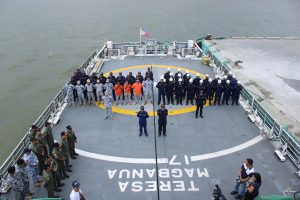The withdrawal of the largest Philippine Coast Guard vessel, the Teresa Magbanua, from the Sabina Shoal in the South China Sea this past weekend demonstrated the success of the Chinese tactic of blockading supplies to the vessel. With its sailors apparently dehydrated and malnourished, Manila decided to pull back its presence on a shoal China claims and by now has established a major presence in.
Observers have noted parallels with the Scarborough Shoal stand-off in 2012. Back then, a similar attempt by the Philippines to assert its rights with its largest naval warship at the time, the Gregorio del Pilar, led to a weeks-long stand-off with the Chinese coast guard. The outcome was a net gain for China; Manila ultimately withdrew, and Beijing took full control of the shoal. Manila is still sore about the failures of Washington’s back-channel role in the 2012 stand-off, as it was led to believe the Chinese would also withdraw simultaneously.
Since the recent upsurge in tensions since last year, Manila has resisted seeking direct U.S. assistance in its multiple clashes with China near the Second Thomas Shoal. These include an incident in June involving aggressive Chinese boarding of Philippine craft. In the context of the Sabina Shoal stand-off, Manila did say it would seek U.S. assistance when its troops were hungry and had no supplies. But when crunch time came, U.S. intervention was apparently not requested.
While China has said it would allow humanitarian supplies to Philippine sailors precariously perched on a rusting ship on the Second Thomas Shoal, no such promises have been made to Manila’s new deployment push at Sabina Shoal. This lowers the threshold for clashes given that the Philippines has promised to replace the Teresa Magbanua with another craft soon.
Where does all this leave the United States? The U.S. INDOPACOM commander had floated the idea of American escorts recently. This was harshly condemned by a top Chinese general, who promised to “resolutely crush any foreign hostile encroachment” while implicitly accusing Manila of being a “pawn” of the United States.
But direct insertion of U.S. troops to protect and resupply Philippine vessels at Sabina or any other site for a future stand-off would qualitatively up the ante and dare China to escalate. It could turn cases of bilateral China-Philippines incidents into a potential great power clash in which the biggest loser would be the Philippines. Manila’s caution thus far in asking for direct U.S. assistance is prudent and understandable.
There should be little doubt that the Philippines is on solid legal ground after the landmark ruling by the Permanent Court of Arbitration in 2016. But, as I have written earlier, what is legal may not always be wise. Manila is indeed – and defiantly – making a legal and moral point. But what is the strategy here? What is the visualized end state and how does the Philippines (and its ally the United States) propose to get there?
As Chinese coercion has become more worrying, the United States has been right in extending diplomatic backing and increasing aid to the Philippines. But Washington has exacerbated the situation in other ways. The expansion of Enhanced Defense Cooperation Agreement (EDCA) sites to northern Luzon entangled the South China Sea issues more deeply with Taiwan – a needless provocation against China. Joint exercises in the South China Sea by the United States with its allies – particularly extra-regional ones such as the U.K. and Canada – send a message of a gathering armed encirclement of China.
Moreover, the presence in northern Philippines of the Typhon mid-range U.S. missile system – capable of launching Tomahawk cruise missiles that could strike the Chinese mainland – has angered Beijing. The Typhon system was temporarily deployed in April as a part of the annual Balikatan joint military exercises. But is still there, more than four months after the exercises were concluded.
None of this takes away the fact that China’s behavior in the South China Sea has been intrusive and coercive and its maritime claims in South China Sea are expansive and illegal. Chinese nationalism has been on the rise since 2012 and is a major factor in the overall escalation.
But territorial disputes, almost by definition, go to the core of states’ perceptions of their sovereignty. Such disputes are among the hardest to resolve. Playing a game of chicken over a territorial dispute without a clear strategy is unwise. This is even more true when it is increasingly entangled with another, separate territorial dispute (Taiwan) and the wider China-U.S. global rivalry. It would be beneficial to insulate these three planes of conflict from each other rather than increasingly short-circuiting them.

































